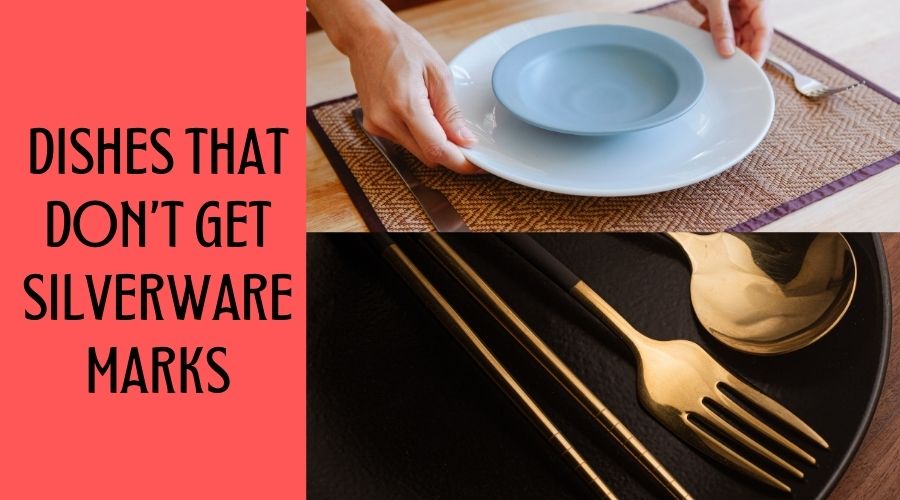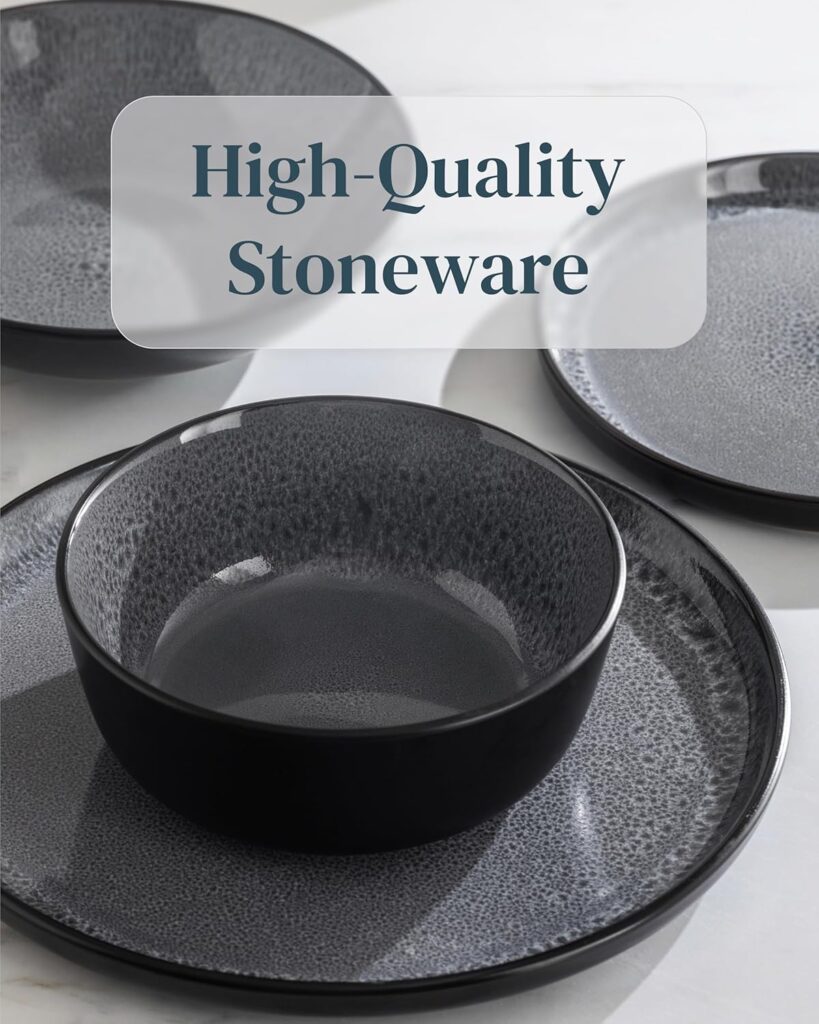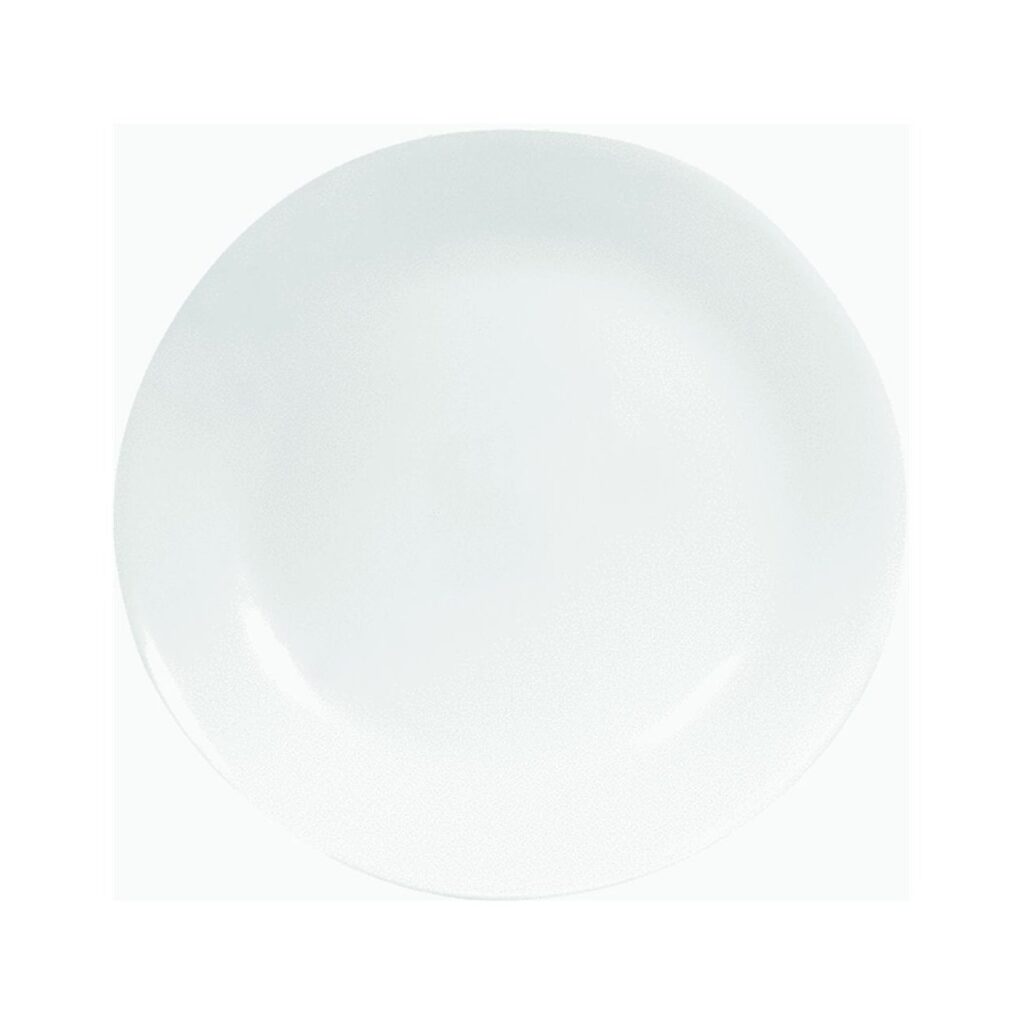You’ve just finished hosting a delightful dinner party, the guests have gone home, and you’re left with a pile of dishes to clean.
As you stack the plates, you notice those familiar grey streaks across your once-pristine dinnerware. Those pesky silverware marks have struck again!
These unsightly scratches not only detract from your beautiful tableware but can also harbour bacteria and reduce the lifespan of your favorite dishes.
Whether you’re tired of constantly scrubbing away at metal marks or looking to invest in new dinnerware that stands up to daily use, you’re in the right place.
Today, we’re diving into the world of scratch-resistant dishes that will keep your table setting looking immaculate meal after meal.
Ready to say goodbye to silverware marks for good?
- WHAT CAUSES SILVERWARE MARKS ON DISHES?
- DOES ALL SILVERWARE LEAVE MARKS ON PLATES?
- DOES PORCELAIN GET CUTLERY MARKS?
- CERAMIC DISHES THAT DON’T GET SILVERWARE MARKS
- BEST SCRATCH-RESISTANT DINNER PLATES
- ARE SCRATCHED PLATES DANGEROUS?
- WHEN TO REPLACE SCRATCHED DINNERWARE
- DISHES TURNING BROWN AND OTHER DISCOLORATION ISSUES
- HOW TO CHOOSE DISHES THAT WON’T GET SILVERWARE MARKS
- BRANDS KNOWN FOR MARK RESISTANCE
- MAINTAINING YOUR DISHES TO PREVENT SILVERWARE MARKS
- THE ROLE OF DURABLE AND HARDENED DINNERWARE SURFACES
- SUSTAINABLE OPTIONS FOR MARK-RESISTANT DINNERWARE
- CONCLUSION
WHAT CAUSES SILVERWARE MARKS ON DISHES?
Before we explore solutions, let’s understand the enemy. Silverware marks (also known as cutlery marks or metal marks) aren’t scratches in most cases.
They’re tiny metal deposits left behind when your metal utensils rub against the surface of your dishes.
The Science Behind the Marks
When metal utensils like knives, forks, and spoons come into contact with your dishes, tiny metal particles can transfer onto the dish surface. This happens through a process similar to abrasion:
- Metal utensils are typically harder than many dish surfaces
- The friction created when cutting, scooping, or scraping causes metal particles to detach
- These particles then deposit onto the softer dish surface, creating those grey or black marks.
This is why you’ll often see these marks appear after vigorous cutting or when someone scrapes their knife across a plate to gather those last bits of food.
Factors That Increase Silverware Marking
Several factors can make your dishes more susceptible to silverware marks:
- Dish material hardness: Softer materials like earthenware and bone china are more prone to marking
- Surface texture: Glossy, smooth surfaces show marks more clearly than textured ones
- Utensil composition: Stainless steel with higher carbon content tends to leave more marks
- Eating habits: Forceful cutting, scraping, and scooping increase the likelihood of marks.
DOES ALL SILVERWARE LEAVE MARKS ON PLATES?
Not all silverware is created equal when it comes to leaving marks on your dishes. Various factors determine how likely your utensils are to leave those annoying grey streaks.
Types of Silverware That Commonly Leave Marks
- Stainless steel utensils: The most common culprits, especially lower-quality ones with higher carbon content
- Silver-plated utensils: Can leave marks, though typically less than stainless steel
- Sterling silver: This genuinely leaves fewer marks than stainless steel but can still cause some marking.
Silverware That Minimizes Marking
- High-quality stainless steel (18/10 or 18/8 grade): Contains more nickel and chromium, making it more resistant to wearing down
- Plastic or silicone-tipped utensils: Great for everyday use as they won’t leave metal marks
- Wooden utensils: They naturally won’t leave metal marks, though they have other limitations
It’s worth noting that how you use your silverware matters just as much as what it’s made of.
Gentle handling and avoiding scraping across plates can significantly reduce marking, regardless of the utensil material.
DOES PORCELAIN GET CUTLERY MARKS?

Porcelain is often touted as a premium dinnerware material, but how does it fare against the dreaded silverware mark?
Porcelain’s Resistance to Marking:

Porcelain is one of the better materials when it comes to resisting silverware marks. Its natural properties include:
- Hardness: High-quality porcelain has a Mohs hardness of around 7, making it harder than most metals used in cutlery
- Smooth glaze: The glass-like surface of well-glazed porcelain provides a barrier that metal has difficulty penetrating
- Density: The compact structure of porcelain makes it less susceptible to surface abrasion
That said, not all porcelain is created equal. The quality of the clay, firing temperature, and glazing process all influence how resistant your porcelain dishes will be to cutlery marks.
Quality Matters
High-quality porcelain dishes that are properly vitrified (fired at high temperatures until they are glass-like) will resist marks better than lower-quality options.

Fine bone china, despite its delicate appearance, is quite resistant to cutlery marks due to its hardness and smooth surface.
If you’re finding that your porcelain dishes are getting marked, it might be worth investing in higher-quality pieces or examining your table habits.
CERAMIC DISHES THAT DON’T GET SILVERWARE MARKS

Ceramic is a broad category that includes everything from earthenware to stoneware to porcelain. Let’s explore which ceramic options best resist those annoying silverware marks.
Best Ceramic Options for Mark Resistance

- Vitrified Stoneware: Fired at high temperatures (2,150-2,330°F), creating a glass-like, non-porous surface that resists marking
- High-fired Porcelain: As mentioned above, quality porcelain can be highly resistant to silverware marks
- Ceramic-Metal Composites: Some modern ceramic dishes incorporate metal particles in the glaze to increase hardness and scratch resistance.
Ceramic Features That Enhance Mark Resistance
- Glazing quality: Smooth, thick, properly applied glazes provide better protection
- Firing temperature: The higher the firing temperature, the more durable and resistant the ceramic becomes
- Additives: Some ceramics include additives like alumina or zirconia to increase hardness
Many manufacturers have developed special glazes specifically designed to resist metal marking.
These typically incorporate harder materials into the glaze formulation, creating a surface that’s less likely to accept metal deposits.
BEST SCRATCH-RESISTANT DINNER PLATES
If you’re in the market for new dinnerware that will resist silverware marks and scratches, here are some excellent options to consider:
Premium Materials

- Tempered Glass Plates: Brands like Duralex and Arcoroc create tempered glass plates that are incredibly resistant to scratches and marks
- Vitrified Stoneware: Look for brands that specifically mention “vitrified” in their description, as this indicates a higher firing temperature
- High-quality Porcelain: Opt for brands known for their fine porcelain like Wedgwood, Royal Doulton, or Lenox.
Innovative Products
Several innovative products have been designed specifically to address the silverware mark problem:
- Corelle Vitrelle Glass Plates: Made with a triple-layer glass construction that’s remarkably resistant to chips, breaks, and silverware marks
- Melamine Dinnerware: Modern melamine plates (like those from Cambridge or Gibson) are far more durable than older versions and resist marking well
- Denby Stoneware: Known for their exceptionally hard glaze that resists both scratching and marking
When shopping for scratch-resistant plates, look for terms like “scratch-resistant,” “mark-resistant,” or “metal-mark resistant” in the product descriptions.
ARE SCRATCHED PLATES DANGEROUS?
Many people wonder about the safety implications of using dishes with silverware marks or scratches. Let’s address these concerns:
Health Concerns with Scratched Plates:
Scratched plates can indeed pose some health and safety issues:
- Bacterial Growth: Deep scratches or cracks can harbour bacteria that regular washing might not remove completely
- Chemical Leaching: In some cases, scratches that penetrate protective glazes might allow chemicals from the underlying materials to leach into food
- Physical Hazards: Very deep scratches or chips might have sharp edges that could potentially cut lips or fingers.
WHEN TO REPLACE SCRATCHED DINNERWARE
While minor silverware marks are generally cosmetic and not dangerous, you should consider replacing dishes that:
- Have deep scratches that catch your fingernail when you run it across the surface
- Show crazing (a network of fine cracks in the glaze)
- Have chips that expose the underlying material
- Cannot be fully cleaned in scratched areas
For dishes with light silverware marks that haven’t penetrated the glaze, there’s typically no safety concern – it’s more an aesthetic issue.
DISHES TURNING BROWN AND OTHER DISCOLORATION ISSUES
Beyond silverware marks, many dishes face other discoloration problems over time. Dishes turning brown is a common complaint, especially with white or light-coloured dinnerware.
This can be caused by:
- Tea and coffee stains that build up over time
- Residue from acidic foods like tomatoes or citrus
- Mineral deposits from hard water
- Improper cleaning techniques
Unlike silverware marks, which are metal deposits on the surface, brown discoloration often results from substances penetrating microscopic pores in the glaze or being absorbed by the material itself.
Regular cleaning with a baking soda paste or denture cleaning tablets can help remove this brownish discoloration and restore your dishes to their original brightness.
HOW TO CHOOSE DISHES THAT WON’T GET SILVERWARE MARKS
When shopping for new dinnerware that will resist silverware marks, consider these factors:
Material Selection:
- Hardness: Choose materials with high Mohs hardness ratings (7+)
- Surface finishing: Look for dishes with extremely smooth, well-glazed surfaces
- Composition: Materials with added hardening agents will perform better
Product Features to Look For:
- Scratch-resistant technology: Many modern brands advertise specific technologies designed to resist marking
- Commercial-grade options: Dinnerware designed for restaurants often has enhanced durability
- Warranty protection: Some premium brands offer warranties against ordinary wear, including silverware marks.
BRANDS KNOWN FOR MARK RESISTANCE
Several brands have built their reputation on creating dinnerware that resists silverware marks:
MAINTAINING YOUR DISHES TO PREVENT SILVERWARE MARKS
Even with the most resistant dinnerware, proper care can further reduce the likelihood of silverware marks:
Handling Practices
- Avoid cutting directly on plates – use cutting boards instead
- Don’t scrape utensils across dishes
- Consider using plastic, silicone, or wooden utensils for everyday meals
- Stack dishes with protective layers between them
Cleaning Techniques
- Use non-abrasive cleaners
- Avoid steel wool or harsh scrubbing pads
- Clean dishes promptly after use
- Consider dishwasher-safe options for more thorough cleaning.
Removing Existing Marks
If your dishes already show silverware marks, try these removal methods:
- Bar Keepers Friend: This mild abrasive cleaner can remove many metal marks without damaging the dish
- Baking soda paste: Mix with water and gently rub with a soft cloth
- Magic Eraser: Works well for surface marks on many materials
- Commercial products: Several products like Wright’s Silver Cream are specifically designed for this purpose.
THE ROLE OF DURABLE AND HARDENED DINNERWARE SURFACES
Modern manufacturing techniques have introduced remarkable advancements in creating durable and hardened dinnerware surfaces that resist silverware marks.
These innovations include:
- Nanotechnology coatings: Ultra-thin protective layers that enhance scratch resistance
- Tempered and strengthened materials: Special heating and cooling processes that increase hardness
- Composite materials: Combining different materials to achieve both strength and aesthetic appeal
Many manufacturers now apply these techniques to create dinnerware that maintains its appearance for years, even with daily use.
These hardened surfaces not only resist silverware marks but also tend to be more chip-resistant and durable overall.
SUSTAINABLE OPTIONS FOR MARK-RESISTANT DINNERWARE
For environmentally conscious consumers, several eco-friendly options also resist silverware marks:
- Bamboo composite dishes: These combine bamboo fibers with food-safe resins to create durable, mark-resistant dishes
- Recycled glass plates: Often tempered for strength and naturally resistant to marking
- Biodegradable plant-based options: Newer materials made from corn, sugarcane, or rice husks with hardening agents
These sustainable options often perform surprisingly well in terms of mark resistance while reducing environmental impact.
CONCLUSION
The quest for dishes that don’t get silverware marks doesn’t have to be an endless struggle.
With the right knowledge about materials, manufacturing techniques, and proper care, you can enjoy beautiful, mark-free dinnerware for years to come.
Whether you choose traditional porcelain, modern tempered glass, or innovative composite materials, understanding what causes silverware marks is the first step to preventing them.
Remember that quality matters – investing in well-made dishes with proper glazing and hardness will save you frustration in the long run.
Next time you’re shopping for dinnerware, look beyond just the pattern and color; consider the durability and mark-resistance that will keep your table setting looking pristine meal after meal.
Your future self – the one who isn’t scrubbing away at metal marks – will thank you!
- Why White Dinnerware Shows Food Best - July 4, 2025
- Are Scratched Plates Dangerous? Complete Safety Guide - July 3, 2025
- How to Get Silverware Marks Off Plates - July 2, 2025